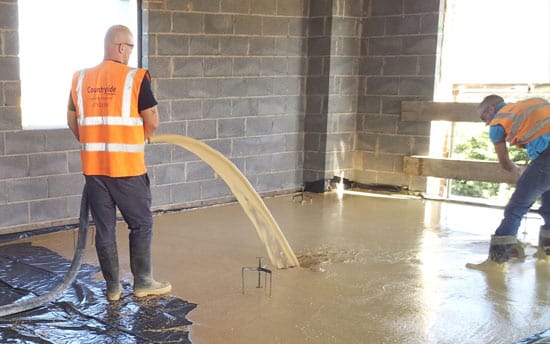
All You Need To Know About Screed – The Complete Floor Screed Guide
If you’re planning on having a new floor fitted it’s possible you may have heard about floor screed, particularly if your existing flooring is uneven. For most people screed isn’t something they will have come across before, so you may be a little unsure about what it is and exactly what it does. Fortunately, we have put together a complete floor screeding guide with all you need to know about screed.
What Is Screed?
Screed is a cementitious material often made from cement and sharp sand and most commonly used as a finishing layer on internal floors for improved appearance and increased durability. This thin layer can vary in thickness from around 50mm to 100mm depending on the application. It is generally laid over a concrete subfloor to create a much smoother texture where other materials can be laid on top of or it is also ideal to cover underfloor heating pipes.
Do I Need To Screed A Concrete Floor?
Laying screed on a concrete floor isn’t something mandatory. It is, however, 100% recommended for levelling uneven floor surfaces and to avoid a bumpy floor. On a previous post, we expanded on the fundamental differences between screed and concrete and the main reasons why you should use screed as a finishing layer. You can read all about it here.
Screed Floor Drying Time
Screed drying time varies depending on the type of screed, the thickness needed and ambient conditions, which makes it difficult to define an exact drying time. However, there are a few standard time ranges to all screeds and conditions that can serve as a general guide.
What Is The Drying Time Until Foot traffic Can Be Allowed?
During the first 24-48h, it is imperative that the site is closed to foot traffic to allow the screed to cure undisturbed. However, as mentioned above, this is a rule of thumb and further guidance on tailored drying times can be found on the BS 8203 code of practice. This curing period is crucial for the screed to achieve sufficient strength. There are several procedures, such as avoiding water ingress, that will help ensure this. Newly laid screeds contain a significant amount of water that will cause it to lose strength if not retained.
How Much Time Is Needed Before The Installation of Floor Covering?
Screed needs an average of 28 days is needed to reach full strength. A BRE screed tester or drop test will then be performed which consists of repeatedly dropping weight to measure the effect of the impact. Only afterwards can the carpets, vinyl or tiles be installed on the surface. A fast track alternative can be our Fast Setting Screeds.
Which Screed Is Better For Underfloor Heating?
Traditional sand and cement screed with polypropylene fibres for unbonded floors have always been effective to cover underfloor heating. However, liquid screeds and self-levelling screeds can be an even better solution as they are more responsive to heating. These types of screed protect the pipes or insulation and are able to retain the heat for longer making it more cost-effective.
Find Out How We Can Help
As one of the leading screeding companies in the UK with more than 30 years of industry experience, it’s safe to say that we are experts when it comes to screed. If you have any questions or are in need of some assistance, get in touch today on 01933 270129 or by filling out an enquiry form.



